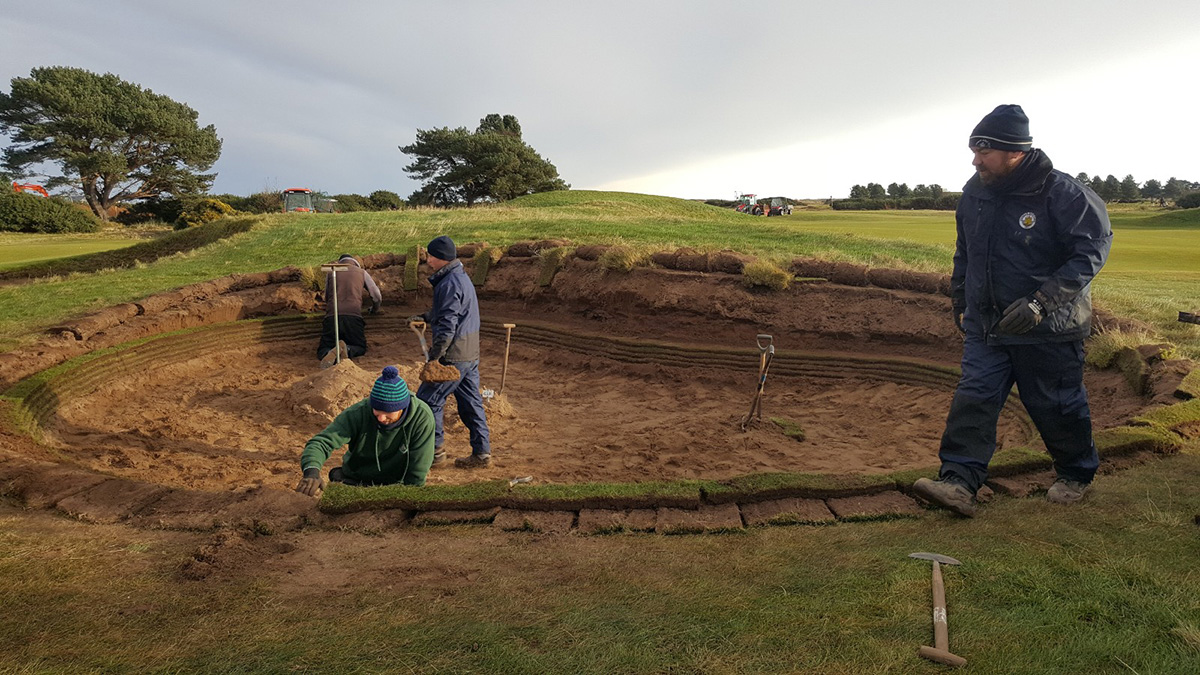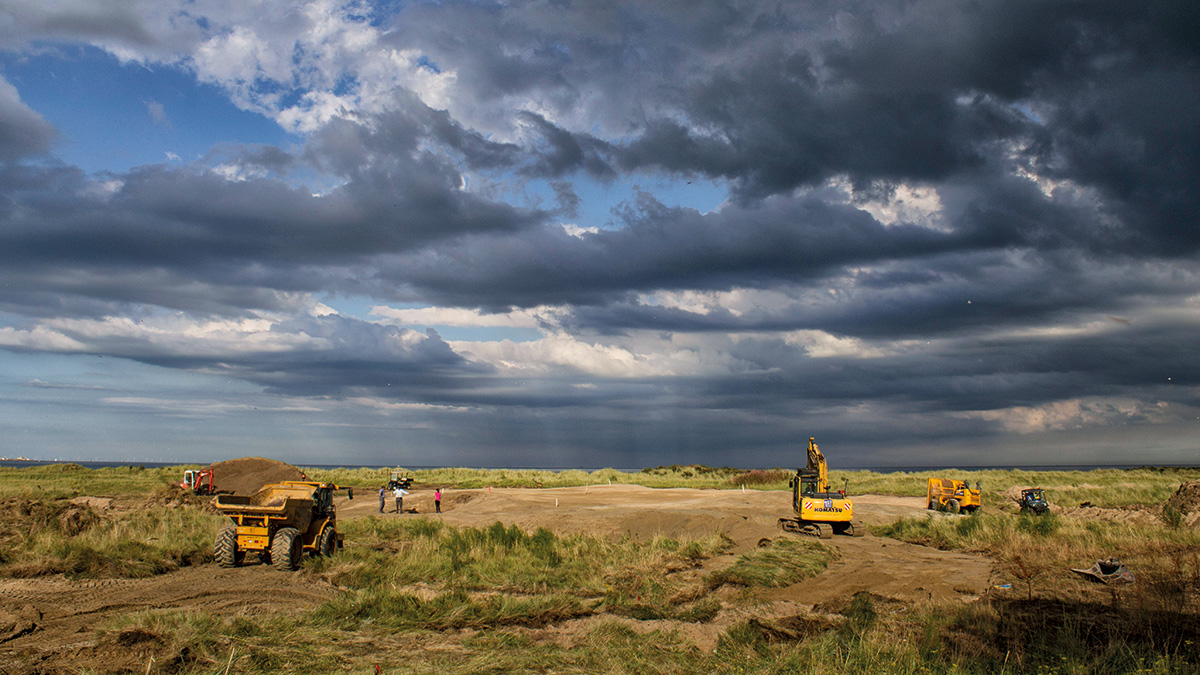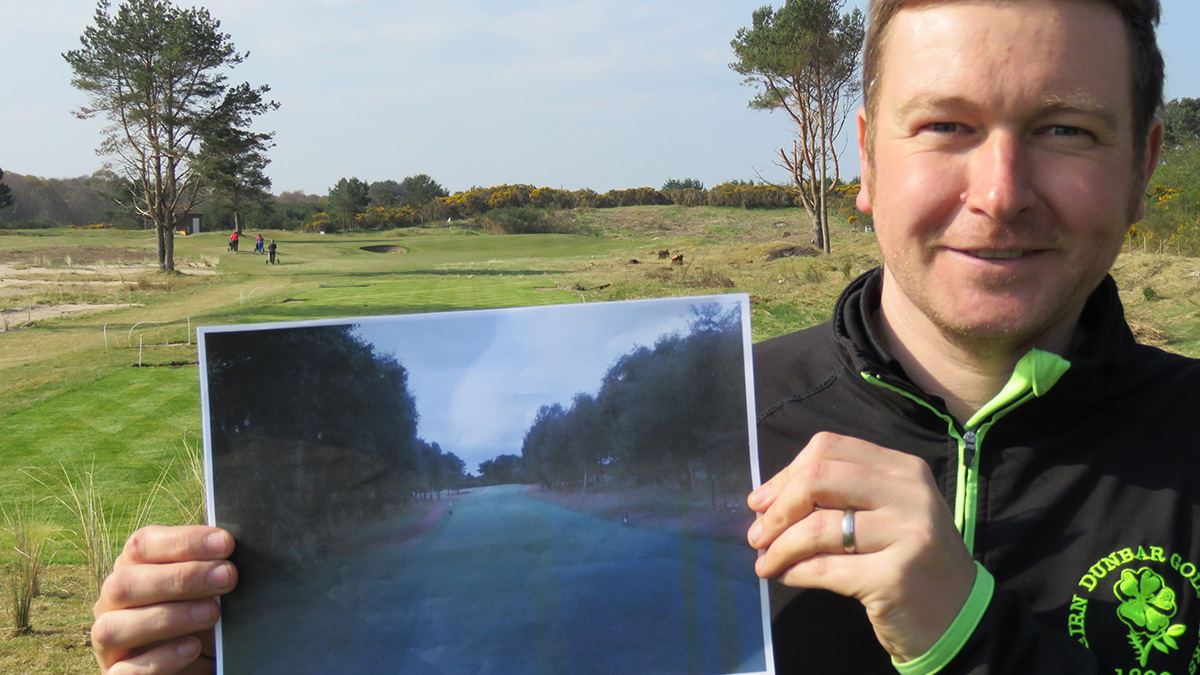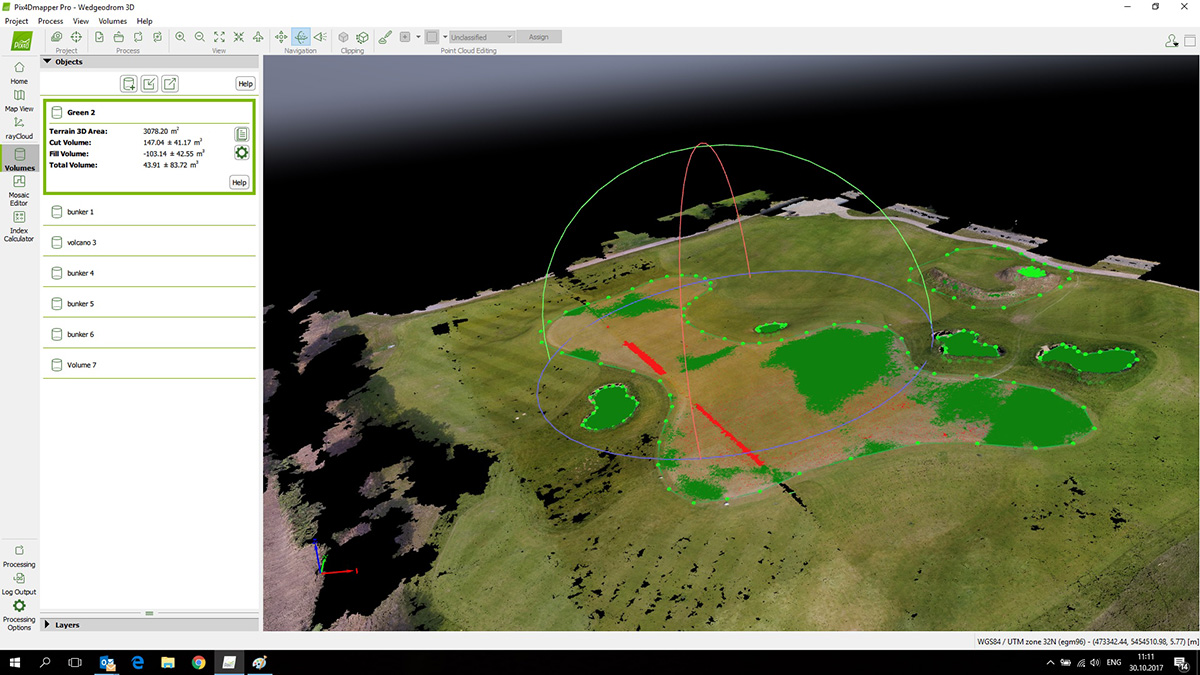- Homepage
- News and Features
- Why winter is hugely important on golf courses
Why winter is hugely important on golf courses
This article was featured in the Spring 2018 edition of Your Course magazine
Winter might be a quieter time for golfers but for greenkeeping staff it can be a season of hard graft.
It is then that maintenance programmes – ranging from constructing a new tee to building new holes – kick into gear as teams carry out projects when fewer golfers are on the fairways.
We talked to the chiefs at three very different golf courses – Open host Carnoustie, Nairn Dunbar in the Scottish Highlands and St Leon Rot in Germany – to find out what they do and why…
Craig Boath, head greenkeeper on the Championship Course at Carnoustie Golf Links, has been rebuilding bunkers ahead of the club hosting The Open in July
Why choose winter to do your rebuilding work?
We are very busy with members and visitors from April until October. In the winter months there is little growth of grass on all areas, so we have time to do other jobs.
We have a winter improvements programme, which runs from November to March each year. This allows the staff the get on with rebuilding tees, aeration work, returfing areas and, this year especially, bunker rebuilding.
What does rebuilding a bunker entail?
We revet our bunkers here at Carnoustie and let the grass grow on the face. A bunker is revetted by layering sods of turf on top of each other and using sand as backfill to keep the turf in place.
A general rule is to keep two fingers’ width from the first row to the next row until you reach the required height.
All bunkers on the course are built to the same height each time. Some bunkers also have cameras added in for filming during The Open.
If anything, we are dropping the bunkers slightly in height due to build up caused by sand splash from golfers playing shots.
The bunkers at Carnoustie are pretty demanding if you land in one – there is no need to make them deeper.
Did you decide to do that work or are The R&A involved?
All work on the course is done in collaboration with The R&A, whether we are in an Open year or not. We always like to tell them what we are doing on the course. We work with The R&A and vice versa to make sure any changes that are made are in keeping with the course.
What else has been going on over the winter?
We have added a few more spectator vantage points, in the way of mounding, and we have taken out a lot of gorse for grandstands, spectator movement and to save some of the heather from being trampled by spectators.
We are also rebuilding our golf centre this year so we will have to be on hand for re-turfing around it – not to mention helping with new roads and fibre optics work around the course. It’s a busy time!
Does the planning for the grandstands begin during the winter or closer to the event?
Grandstand positions are planned for well in advance by The R&A and construction of them will begin around the middle of April.
We roughly know from the last Open where they are situated, so we like to keep those areas clean of gorse. This is mainly to ensure there are no tripping hazards.

How much would the winter weather affect what kind of maintenance is carried out during the off-season?
It’s the same as through the summer months. You just have to plan your day, week and month around the conditions – whether it’s solid with frost or glorious sunshine.
You always have to keep an eye on the weather and take advantage when you can.
What is the most frustrating thing about winter maintenance?
The lack of daylight and the change in staffing hours. We go down to a 35-hour week from the end of November to the end of January. It’s a short day but you have to try and get as much out of everyone as possible.
Carnoustie is busy throughout the year. How does this affect the changes you can make in the winter?
We are a good bit quieter in the winter period with fewer visitors. But I would say that winter is our busy time – bunker building, tee alterations, cutting back of roughs, mounding and so on. We don’t do a lot of drastic changes, just little bits here and there if needed.
Carnoustie is one of the driest places in the UK. Does it affect your work at this time?
It’s not too bad. We can get on with work in most conditions. There is not too much growth through the winter, so that takes care of itself.
You just have to plan your work around the weather as you would in the summer.
I always make sure I have a secondary job in mind for the guys, just in case conditions change during the day with rain or snow or frozen ground, for example.

You will be very proud when The Open arrives and the course is shown all over the world. Is getting it ready nerve-wracking or exciting?
I’m not too excited yet, but that will probably change nearer the event. I am very proud of the work the guys have achieved this winter.
A lot of the staff here have been involved in working at an Open before and we have had a lot of other events through the years. Keeping everyone calm will be key.
We just need to focus on giving the best players in the world the best conditions and try not to get too distracted.
Understanding the elements and his team’s limitations is key to the work Nairn Dunbar course manager Richard Johnstone does during the winter…
You’re based in the north of Scotland, so what are the biggest factors you have to take into account when looking at winter maintenance?
We will experience temperatures of around five degrees and below from November right through until April. This means there is very little growth to aid recovery.
Through these months, we experience cold north winds, freezing temperatures and snow, which affects the amount of work we can get completed.
We aim to start our construction work – such as bunkers, tees and re-turfing worn areas – in October to give these the chance to knit together before the season starts at the end of March.
Historically, the worst months for inclement weather are January and February, so during these months we have a gorse and tree management plan in place to focus on.
What have you been doing this winter?
This year’s winter projects include adding five new revetted bunkers to the 60 we already have on the course. They will improve strategy on our wider holes, help engage golfers more and improve aesthetics throughout the course.
We aim to reconstruct another eight, which we normally do on a rotational basis, with the most used lasting only five years.
Our biggest project is new tees at the 10th hole, with a new championship and men’s tee being constructed among newly uncovered dune systems with views over the Moray Firth.
We are reconstructing the 3rd and 16th teeing grounds to give a level playing surface.
Out of season rough management and tree and gorse management will all help restore Nairn Dunbar to unveil its original links-like characteristics.
What is the most frustrating thing about winter maintenance?
The inclement weather – which can change your plans from day-to-day – and staffing levels, which play a big part in what we can achieve.
With only five staff looking after our Championship course, it can sometimes be difficult to carry out as much as we would like.
With holidays usually being taken out of season, we are understaffed most of the winter months.
Why does this work take place during the winter?
There is less competitive golf and visitors playing the course, meaning there is less disruption to play and it allows us to leave projects as ground under repair until the season starts in the spring.
The low temperatures during winter also meant there is less cutting to be done and more time to focus on winter projects.

What can golfers do to help you get the course into top condition in time for the season?
It is essential that golfers respect the course throughout the year by repairing pitchmarks and replacing divots. During the winter period, we also ask if they follow appropriate signage used throughout the course to spare wear and tear.
We have forward winter tees in use from November until March, with artificial mats placed on the four par 3s and a fairway mat system used where golfers have the option to play the ball from a mat on the fairway or lift and drop in the rough without a mat.
This system has been in place for a number of years and has been essential to the condition of our fairways and tees going into spring.
During construction we also have various forms of ground under repair in place, where we ask members to respect these areas by lifting and dropping outside the roped off areas.
How would what you do compare with a course in the south of England? Do you have to do more?
I think most courses go through a similar process with winter maintenance where weather allows.
The south of England will have a higher average temperature than we receive in the north of Scotland throughout the winter months, which will allow more construction work to be carried out.
Other maintenance, such as overseeding and thatch removal or dilution can be carried out later or earlier in the season, when the higher temperatures will aid recovery.
Sometimes another way of looking at things can make all the difference, as this German club has demonstrated…
CCTV is often called the eye in the sky but for more and more golf clubs, it’s a camera of a different kind that’s changing the way winter work is carried out.
We’re all aware of drones being used to show off a layout at its best – there’s videos all over social media. But at St Leon-Rot, which hosted the Solheim Cup in 2015, superintendent Craig Cameron has utilised the technology for a very different means.

He uses drones to digitally record work happening around the course, such as drainage installations and bunker renovations, as well as surveying.
He began using drones while at Aldeburgh in Suffolk.
“I started using my drone to take photographs of the course and then moved up to using it for behind the scenes – what we do on the course – in short videos,” he said. “I did a behind-the-scenes greenkeepers’ video at the BMW PGA Championship and one for the Solheim Cup. From there, it progressed to drone surveying. That is surveying the whole area so you can measure any part of the course – bunkers, fairways, tees and greens.
“That helps us when we’re doing construction because, if we have work to do and we need to order turf, then I can take the drone out and do a quick survey and know exactly how much turf to order,” said Craig. “It’s great if you’re working with external firms because you can let them fire on ahead and you can be sitting behind them measuring as you’re going along and order turf when you require it. And it’s fairly accurate, so there’s no wastage.”
Providing videos for customers and members has been another one of the benefits.
Craig explained: “You fly all the sites in one video and then edit it together. You get one video saying exactly what you did over the winter, which helps a lot because we’ve done lots of work and people come back from the winter holiday and don’t realise.”
What will your greenkeepers be doing this winter to maintain and improve the golf course? Have a conversation with your team and find out more.
Tags
Author

